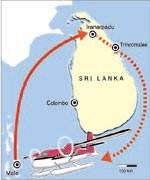| Front
Page |
||||||
|
Bala flies over
Trinco drama
A sea plane carrying LTTE chief negotiator Anton Balasingham to the Maldives last Wednesday risked attack by the Air Force after it diverted course and flew low over a flotilla of boats the Navy had surrounded in the seas off Foul Point in Trincomalee. Since the departure of Dr. Balasingham was a top secret, both the Navy and the Air Force in Trincomalee were completely unaware of the presence of any foreign aircraft in the region. Naval craft which spotted the sea plane promptly radioed the Operations Room of the Air Force Base in China Bay. Whilst making preparations to intercept or attack the sea plane, the Base had made urgent contact with Air Force Headquarters to report the sighting. It was only thereafter that they were advised to stand down. Accompanied by at least two guerrilla cadres, Dr. Balasingham had boarded a sea plane of the Maldivian Air Taxis from the Iranamadu tank last Wednesday for his journey to the Maldivian capital of Male - the first leg of his return trip to London. From there he was to fly to Dubai. The diversion of the flight is learnt to have been prompted by the Navy placing a cordon on a flotilla of four Sea Tiger boats loaded with weapons and carrying some top rung leaders. They had set off from their base in Chalai. The first stop had been some four miles off the shores of Foul Point. Here, Trincomalee guerrilla leader had boarded a smaller boat to come ashore with four others. Thereafter the Sea Tiger flotilla was to proceed to waters off Batticaloa to drop off eastern "military commander" Karuna and Batticaloa Ampara leader Karikalan. There was hectic excitement in the intelligence community after radio intercepts between the Sea Tiger flotilla and a base somewhere in the Wanni jungles revealed that among those trapped by the Naval cordon was Pottu Amman, guerrilla intelligence wing leader and a most wanted man worldwide for the murder of former Indian Prime Minister Rajiv Gandhi. Naval patrols had reported that they saw several weapons fixed to the Sea Tiger boats. In view of the Ceasefire Agreement, naval patrols withdrew. According to one high-ranking Navy source, this was after "we received orders from Colombo to relax the cordon." Thereafter the Sea Tiger flotilla had moved towards Batticaloa area and returned to Chalai. The incident has caused serious concerns at the highest levels of the Government. They are worried particularly about the consequences that would have followed if the Air Force, or even the Navy, engaged the sea plane on the grounds that it was an unidentified aircraft intruding Sri Lankan air space. The Peace Secretariat has been briefed of the events and asked to apprise the Sri Lanka Monitoring Mission (SLMM) of the sequence of events. When permission was granted for a Maldivian Air Taxis sea plane to enter Sri Lankan air space and touch down at the Iranamadu tank, it was agreed that such a flight should be covered only by a time corridor. In other words, the sea plane was permitted to fly its own course within a stipulated time, drop Dr. Balasingham, his entourage and take off. During this period, arrangements were made to ensure no other aircraft operated in the vicinity. The sea plane bringing in Dr. Balasingham, two other guerrilla cadres and Tomas Stangeland of the Norwegian High Commission landed on the Iranamadu tank on March 25. Its flight path was almost entirely over the Indian ocean. It had entered land over the general area of Mullaitivu. Neither Colombo Air control nor Colombo radar that monitor all incoming flights make any radio contact with the sea plane. Maldivian Air Taxi's Canadian pilots had arrived in Colombo in advance and worked out procedures where they maintained total radio silence. Even Air Force Air Traffic Control Towers did not hear any radio communication. However, during the return journey, the sea plane had deviated far away from its expected flight path and operated over the seas near Tincomalee. Intelligence sources believe the move was intended as a show of strength after the Navy placed a cordon on Sea Tiger boats. The Sunday Times learns that the Government, through Norwegian mediators, will work out fresh procedures for any future flights that may land in the Iranamadu tank. This is likely to include a requirement that the guerrillas file a confidential flight plan giving their route. Government sources insist this is not a move to place restrictions but to ensure untoward developments do not lead to any confrontational situation. |
||||||
Copyright © 2001 Wijeya Newspapers
Ltd. All rights reserved. |

